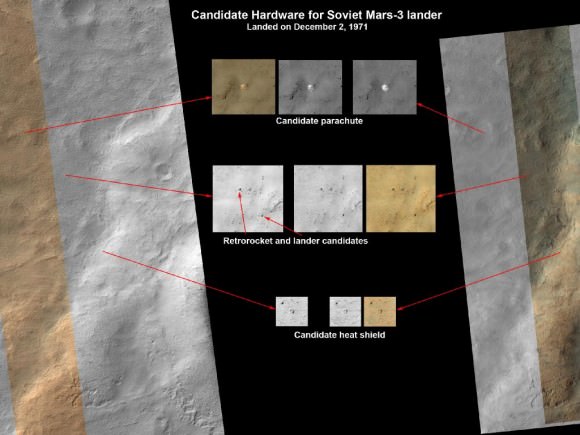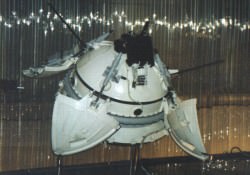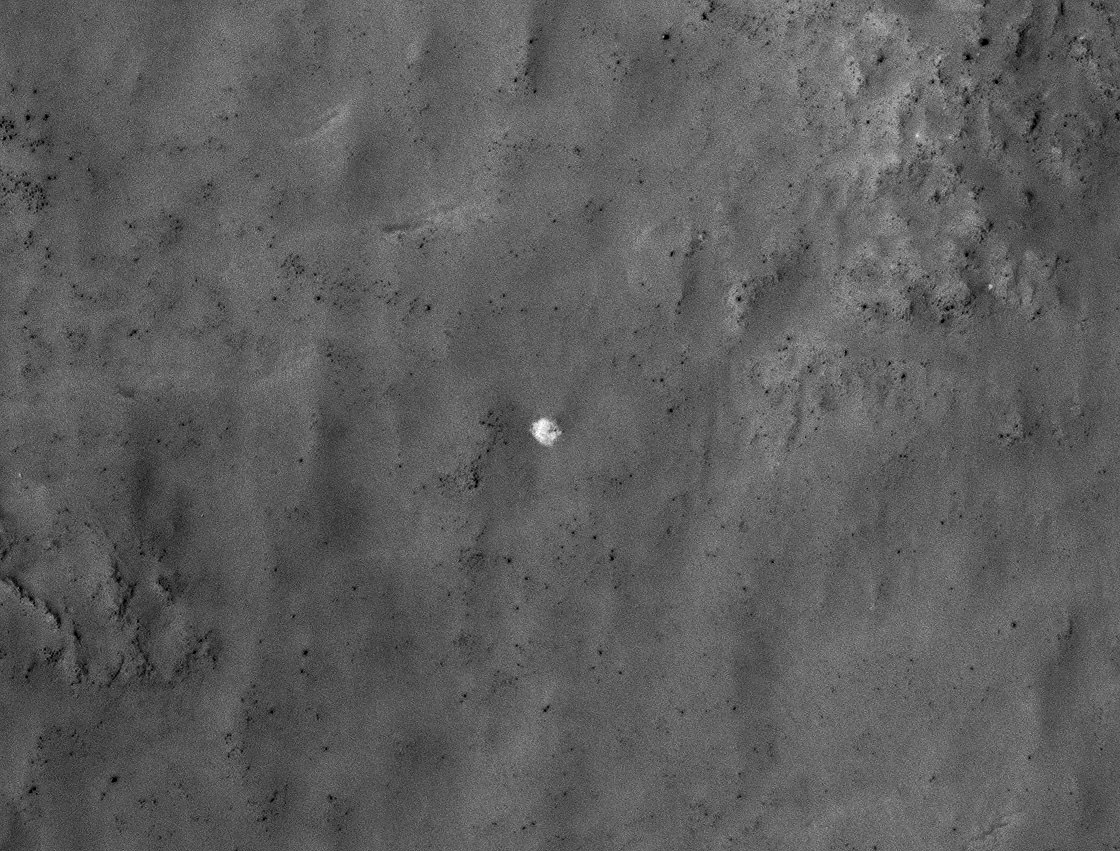On May 28, 1971, the Soviet Union launched the Mars 3 mission which, like its previously-launched and ill-fated sibling Mars 2, consisted of an orbiter and lander destined for the Red Planet. Just over six months later on December 2, 1971, Mars 3 arrived at Mars — five days after Mars 2 crashed. The Mars 3 descent module separated from the orbiter and several hours later entered the Martian atmosphere, descending to the surface via a series of parachutes and retrorockets. (Sound familiar?) Once safely on the surface, the Mars 3 lander opened its four petal-shaped covers to release the 4.5-kg PROP-M rover contained inside… and after 20 seconds of transmission, fell silent. Due to unknown causes, the Mars 3 lander was never heard from or seen again.
Until now.

The set of images above shows what might be hardware from the 1971 Soviet Mars 3 lander, seen in a pair of images from the High Resolution Imaging Science Experiment (HiRISE) camera on NASA’s Mars Reconnaissance Orbiter.
While following news about Mars and NASA’s Curiosity rover, Russian citizen enthusiasts found four features in a five-year-old image from Mars Reconnaissance Orbiter that resemble four pieces of hardware from the Mars 3 mission: the parachute, heat shield, terminal retrorocket and lander. A follow-up image by the orbiter from last month shows the same features.
“Together, this set of features and their layout on the ground provide a remarkable match to what is expected from the Mars 3 landing, but alternative explanations for the features cannot be ruled out.”
– Alfred McEwen, HiRISE Principal Investigator

Vitali Egorov from St. Petersburg, Russia, heads the largest Russian Internet community about Curiosity. His subscribers did the preliminary search for Mars 3 via crowdsourcing. Egorov modeled what Mars 3 hardware pieces should look like in a HiRISE image, and the group carefully searched the many small features in this large image, finding what appear to be viable candidates in the southern part of the scene. Each candidate has a size and shape consistent with the expected hardware, and they are arranged on the surface as expected from the entry, descent and landing sequence.
“I wanted to attract people’s attention to the fact that Mars exploration today is available to practically anyone,” Egorov said. “At the same time we were able to connect with the history of our country, which we were reminded of after many years through the images from the Mars Reconnaissance Orbiter.”
The predicted Mars 3 landing site was at latitude 45 degrees south, longitude 202 degrees east, in Ptolemaeus Crater. HiRISE acquired a large image at this location in November 2007, and promising candidates for the hardware from Mars 3 were found on Dec. 31, 2012.

The candidate parachute is the most distinctive feature in the images (seen above at top.) It is an especially bright spot for this region, about 8.2 yards (7.5 meters) in diameter.
The parachute would have a diameter of 12 yards (11 meters) if fully spread out over the surface, so this is consistent.
“Together, this set of features and their layout on the ground provide a remarkable match to what is expected from the Mars 3 landing, but alternative explanations for the features cannot be ruled out,” said HiRISE Principal Investigator Alfred McEwen of the University of Arizona, Tucson. “Further analysis of the data and future images to better understand the three-dimensional shapes may help to confirm this interpretation.”
Source: NASA/JPL


Another fine reason to retrofit an old KH-11 spy *.sat and send it on out to Mars!
Is this the start of Mars archaeology or is it still history, lander being covered with sand ?
Do robot fossils count as fossils ? They should, if they are dug up, i think ..
Quite “literally ““having been dug up“”, as I’m sure you know. Scientifically only organism remains or traces count so far, but languages change over time and due to the construction the generalization suggest itself.
There is a practical separation between history and fossils though. Eg “a preserved specimen is called a “fossil” if it is older than some minimum age, most often the arbitrary date of 10,000 years.” (I.e. a date set well before written history as we know it.)
These remains would then always remain history. But who knows what limit a putative future AI subsociety would chose? Their own written history hasn’t started yet.
Wouldn’t they be ‘artifacts’?
This news is very interesting. Moon was discovered so much
For next missions, parachute patch colours may be considered more to satisfy detection requirements…Only white may not be enough…
lol…yeah, a rainbow chute.
actually, idea of color patterned parachutes is usefull. We still can’t find Mars Polar Lander or Beagle 2.
Was kidding Goz. Yes, I realize a few probes not being located. About 15 years ago, I had an idea of using commercial companies w/their LOGO -bright color(s)- for advertisement on the sides of rockets, chutes etc.. . It would help NASA w/”$” & would help divert ‘costs’. What do you think? …take care
The candidate parachute is the most distinctive feature in the images. It is so awesome